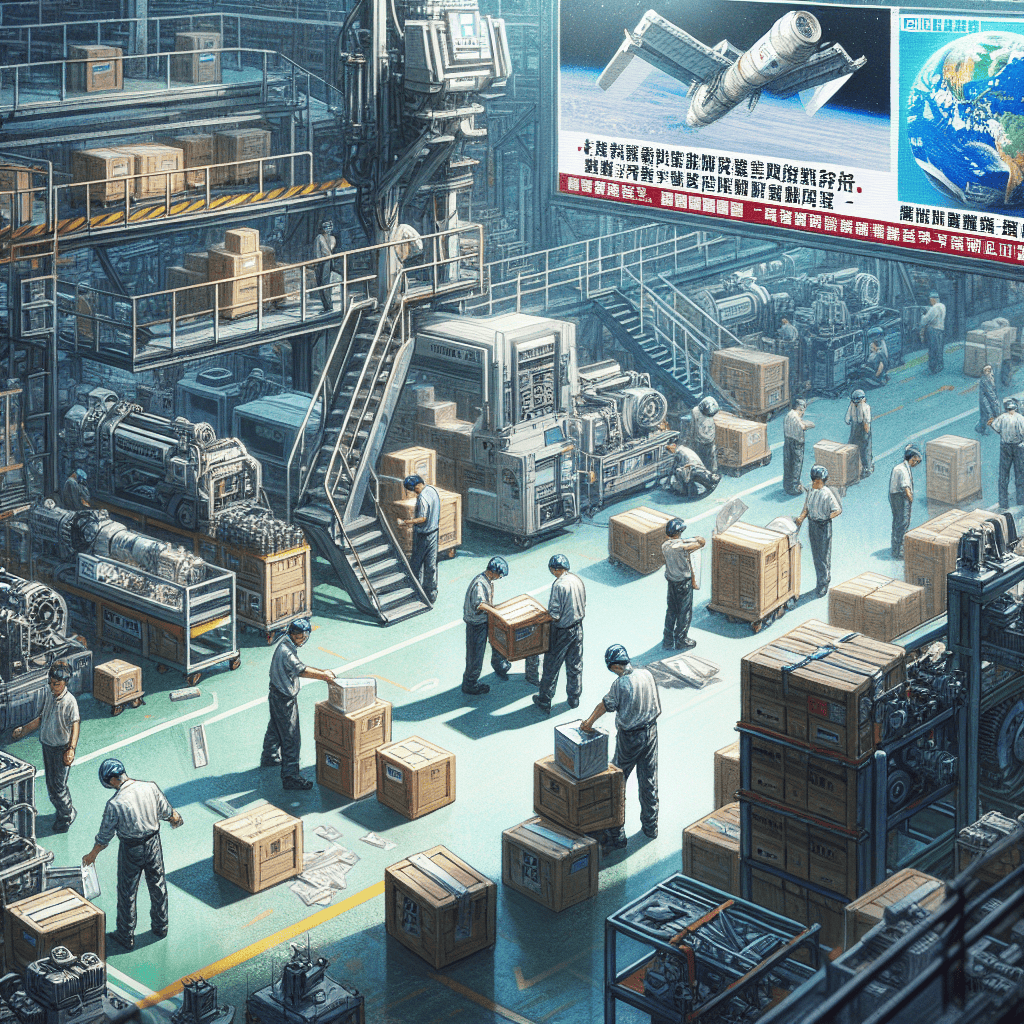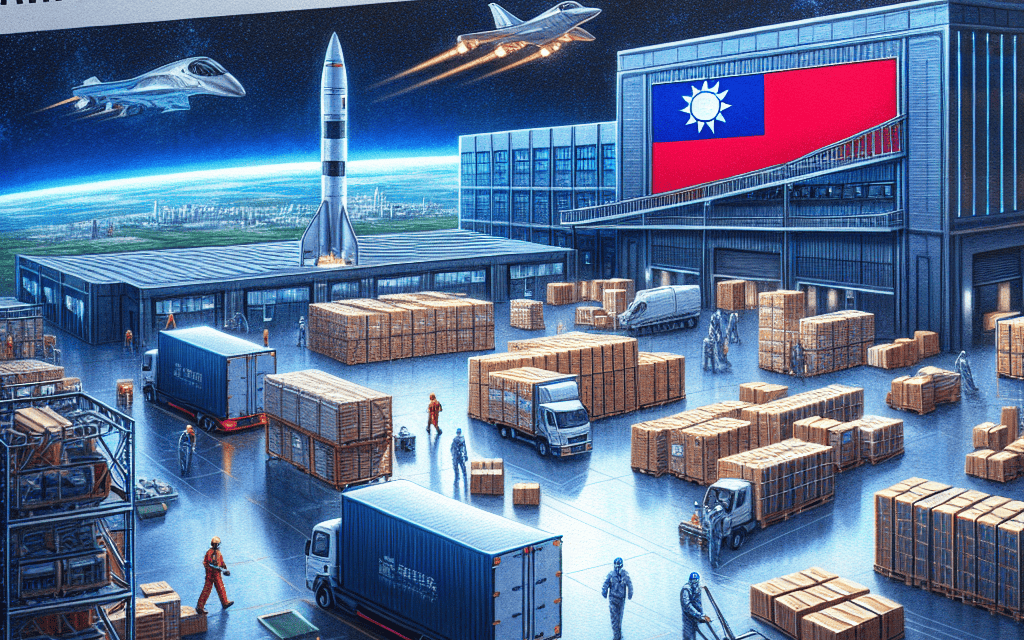“Taiwanese Suppliers Shift Gears: Meeting SpaceX’s Global Production Demands”
Introduction
In response to strategic requests from SpaceX, several Taiwanese suppliers are reportedly relocating their production facilities overseas. This move is part of a broader effort to align with SpaceX’s operational requirements and to mitigate geopolitical risks associated with the Taiwan Strait. The relocation aims to ensure a more resilient supply chain and to meet the increasing demand for advanced aerospace components. Sources indicate that this shift could significantly impact the global aerospace supply network, as Taiwanese companies play a crucial role in the production of high-tech components essential for space exploration and satellite technology.
Impact Of SpaceX Requests On Taiwanese Suppliers’ Global Strategies
In recent developments, Taiwanese suppliers have been prompted to reevaluate their global strategies due to specific requests from SpaceX, a leading aerospace manufacturer and space transportation company. This shift underscores the growing influence of major tech companies on global supply chains and highlights the strategic maneuvers suppliers must undertake to remain competitive in an increasingly interconnected world. According to sources familiar with the matter, SpaceX has encouraged its Taiwanese partners to relocate certain production facilities overseas. This move is primarily driven by SpaceX’s desire to streamline its supply chain, reduce costs, and mitigate potential geopolitical risks associated with concentrated production in Taiwan.
The implications of these requests are significant, as they compel Taiwanese suppliers to reassess their operational footprints. By relocating production facilities to other countries, these suppliers can potentially benefit from lower labor costs, favorable trade agreements, and proximity to other key markets. Moreover, diversifying production locations can help mitigate risks associated with natural disasters, political instability, or trade tensions that may arise in any single region. Consequently, this strategic realignment not only aligns with SpaceX’s objectives but also positions Taiwanese suppliers to enhance their resilience and adaptability in a rapidly changing global landscape.
Furthermore, the relocation of production facilities is likely to have a ripple effect on the broader supply chain ecosystem. As Taiwanese suppliers establish new operations overseas, they may forge new partnerships with local businesses, thereby fostering economic growth and development in those regions. This expansion can lead to the creation of new jobs, the transfer of technology and expertise, and the strengthening of local infrastructure. In turn, these developments can contribute to the overall competitiveness of the host countries, making them more attractive destinations for future investments.
However, the decision to relocate production is not without its challenges. Taiwanese suppliers must navigate complex regulatory environments, cultural differences, and logistical hurdles as they establish new operations abroad. Additionally, they must ensure that the quality and consistency of their products are maintained, as any disruptions could have significant repercussions for their relationships with SpaceX and other clients. To address these challenges, suppliers may need to invest in robust training programs, establish clear communication channels, and implement rigorous quality control measures.
Moreover, the strategic shift prompted by SpaceX’s requests may also influence the broader Taiwanese manufacturing sector. As key suppliers relocate production overseas, other companies may follow suit, leading to a potential reconfiguration of Taiwan’s industrial landscape. This could result in a more diversified and globally integrated manufacturing sector, with Taiwanese companies leveraging their expertise and innovation capabilities to compete on a global scale.
In conclusion, the requests from SpaceX for Taiwanese suppliers to relocate production overseas have far-reaching implications for their global strategies. By embracing this opportunity, suppliers can enhance their competitiveness, resilience, and adaptability in an ever-evolving global market. While challenges remain, the potential benefits of this strategic realignment are substantial, offering Taiwanese suppliers the chance to expand their reach, forge new partnerships, and contribute to economic growth in new regions. As the global supply chain continues to evolve, the ability to adapt and innovate will be crucial for companies seeking to thrive in this dynamic environment.
Key Factors Driving Taiwanese Suppliers To Relocate Production Overseas
In recent developments, Taiwanese suppliers have been increasingly relocating their production facilities overseas, a move reportedly influenced by requests from SpaceX. This strategic shift is driven by a confluence of factors that are reshaping the global supply chain landscape. As the demand for advanced aerospace components continues to rise, suppliers are compelled to adapt to the evolving needs of their clients, particularly those with ambitious projects like SpaceX. The decision to move production overseas is not made lightly, as it involves significant logistical, financial, and strategic considerations.
One of the primary factors driving this relocation is the need for proximity to key markets. By establishing production facilities closer to their clients, Taiwanese suppliers can reduce lead times and enhance their responsiveness to changing demands. This geographical shift allows for more efficient supply chain management, which is crucial in an industry where time is often of the essence. Moreover, being closer to SpaceX’s operations in the United States can facilitate better communication and collaboration, ensuring that the suppliers can meet the stringent quality and performance standards required by the aerospace giant.
In addition to proximity, cost considerations play a pivotal role in the decision to relocate production. While Taiwan has long been a hub for high-tech manufacturing, rising labor costs and increasing competition have prompted suppliers to seek more cost-effective locations. By moving production to countries with lower labor costs, suppliers can maintain their competitive edge while still delivering high-quality products. This cost optimization is essential in an industry where margins can be tight, and efficiency is paramount.
Furthermore, the geopolitical landscape is another critical factor influencing this trend. The ongoing tensions between the United States and China have created an environment of uncertainty, prompting companies to diversify their production bases to mitigate risks. By relocating production to countries with more stable political climates, Taiwanese suppliers can safeguard their operations against potential disruptions. This strategic diversification not only reduces dependency on any single market but also enhances the resilience of the supply chain.
Additionally, the pursuit of technological innovation is driving suppliers to explore new production locations. Many countries offer attractive incentives for companies investing in advanced manufacturing technologies, such as automation and artificial intelligence. By tapping into these opportunities, Taiwanese suppliers can enhance their production capabilities and remain at the forefront of technological advancements. This focus on innovation is crucial for meeting the evolving demands of clients like SpaceX, who require cutting-edge solutions for their ambitious projects.
Moreover, environmental considerations are increasingly influencing production decisions. As global awareness of sustainability issues grows, companies are under pressure to adopt greener practices. Relocating production to countries with more stringent environmental regulations can help suppliers align with these expectations and reduce their carbon footprint. This commitment to sustainability not only meets the demands of environmentally conscious clients but also enhances the company’s reputation in the global market.
In conclusion, the relocation of Taiwanese suppliers’ production facilities overseas is driven by a complex interplay of factors, including proximity to key markets, cost considerations, geopolitical stability, technological innovation, and environmental sustainability. As the aerospace industry continues to evolve, suppliers must remain agile and responsive to the changing landscape. By strategically relocating their production, Taiwanese suppliers are positioning themselves to better serve clients like SpaceX while navigating the challenges and opportunities of the global market.
Challenges Faced By Taiwanese Suppliers In Overseas Relocation
In recent years, Taiwanese suppliers have increasingly faced the challenge of relocating their production facilities overseas, a trend that has been notably influenced by requests from major clients such as SpaceX. This shift is not merely a logistical undertaking but a complex process fraught with numerous challenges that these suppliers must navigate. The decision to move production abroad is often driven by the need to meet client demands for proximity, cost efficiency, and enhanced supply chain resilience. However, the transition is not without its hurdles, which range from regulatory compliance to cultural adaptation.
One of the primary challenges faced by Taiwanese suppliers in this relocation process is the intricate web of regulatory requirements in the host countries. Each nation has its own set of laws and regulations governing foreign business operations, including labor laws, environmental standards, and tax obligations. Navigating these legal landscapes requires significant expertise and resources, often necessitating the hiring of local legal counsel and compliance officers. This can be a costly endeavor, particularly for small to medium-sized enterprises that may not have the financial flexibility of larger corporations.
Moreover, the relocation process demands a deep understanding of the local market dynamics and business culture. Taiwanese suppliers must adapt to different business practices and consumer preferences, which can vary significantly from those in Taiwan. This cultural adaptation is crucial for establishing successful operations and building strong relationships with local partners and clients. However, it can also be a source of tension and misunderstanding if not managed carefully. Language barriers, differing negotiation styles, and varying expectations can all pose significant challenges to effective communication and collaboration.
In addition to regulatory and cultural challenges, logistical issues also play a significant role in the overseas relocation process. Establishing a new production facility involves considerable planning and investment in infrastructure, technology, and human resources. Suppliers must ensure that their new operations can meet the quality and efficiency standards expected by clients like SpaceX. This often requires the transfer of technology and expertise from Taiwan to the new location, which can be a complex and time-consuming process. Furthermore, suppliers must also consider the implications of relocating their supply chains, including the sourcing of raw materials and components, which may not be readily available in the host country.
Financial considerations are another critical aspect of the relocation process. The initial investment required to set up operations overseas can be substantial, encompassing costs related to land acquisition, construction, equipment, and workforce training. Additionally, suppliers must manage the ongoing operational costs, which may differ significantly from those in Taiwan due to variations in labor costs, utility expenses, and other factors. Securing financing for these endeavors can be challenging, particularly in uncertain economic climates.
Despite these challenges, the potential benefits of relocating production overseas can be significant. By establishing a presence closer to key clients like SpaceX, Taiwanese suppliers can enhance their competitiveness, reduce lead times, and improve their ability to respond to client needs. Moreover, diversifying their production locations can help mitigate risks associated with geopolitical tensions and trade disruptions. However, to successfully navigate the complexities of overseas relocation, Taiwanese suppliers must adopt a strategic approach, leveraging local expertise and building strong partnerships to overcome the myriad challenges they face.
Benefits Of Overseas Production For Taiwanese Suppliers In The Space Industry

In recent years, the global space industry has witnessed a significant transformation, with companies like SpaceX leading the charge in innovation and expansion. As part of this evolution, Taiwanese suppliers have increasingly been called upon to meet the growing demands of this dynamic sector. In response to requests from SpaceX, many of these suppliers are relocating their production facilities overseas, a move that offers a multitude of benefits. This strategic shift not only aligns with the global nature of the space industry but also provides Taiwanese suppliers with several competitive advantages.
One of the primary benefits of relocating production overseas is the potential for cost reduction. By establishing manufacturing facilities in countries with lower labor and operational costs, Taiwanese suppliers can significantly decrease their production expenses. This cost efficiency is crucial in an industry where price competitiveness is a key factor in securing contracts. Moreover, by reducing production costs, suppliers can offer more competitive pricing to their clients, thereby enhancing their market position and increasing their chances of securing long-term partnerships with major players like SpaceX.
In addition to cost savings, relocating production overseas allows Taiwanese suppliers to be closer to their clients and end markets. This proximity can lead to improved logistics and supply chain efficiency, as shorter transportation distances reduce lead times and shipping costs. Furthermore, being closer to clients enables suppliers to respond more swiftly to changes in demand or specifications, thereby enhancing their ability to provide timely and customized solutions. This agility is particularly important in the fast-paced space industry, where the ability to adapt quickly to new requirements can be a decisive factor in maintaining a competitive edge.
Another significant advantage of overseas production is access to a broader talent pool. By establishing operations in different regions, Taiwanese suppliers can tap into local expertise and skills that may not be readily available in Taiwan. This access to diverse talent can foster innovation and drive the development of new technologies and processes, which are essential for staying ahead in the rapidly evolving space industry. Additionally, by integrating local knowledge and perspectives, suppliers can better tailor their products and services to meet the specific needs of different markets, further enhancing their global competitiveness.
Furthermore, relocating production facilities overseas can help Taiwanese suppliers mitigate risks associated with geopolitical tensions and trade barriers. By diversifying their manufacturing locations, suppliers can reduce their reliance on any single market and better navigate potential disruptions. This diversification not only provides a buffer against geopolitical uncertainties but also positions suppliers to take advantage of new opportunities in emerging markets. As the space industry continues to expand globally, having a presence in multiple regions can be a significant strategic advantage.
In conclusion, the decision by Taiwanese suppliers to relocate production overseas in response to SpaceX’s requests is a strategic move that offers numerous benefits. From cost reduction and improved logistics to access to a broader talent pool and risk mitigation, overseas production provides Taiwanese suppliers with the tools they need to thrive in the competitive space industry. As the global demand for space-related products and services continues to grow, these suppliers are well-positioned to capitalize on new opportunities and strengthen their partnerships with industry leaders like SpaceX. Through strategic relocation, Taiwanese suppliers are not only enhancing their operational capabilities but also contributing to the broader advancement of the global space industry.
How SpaceX’s Supply Chain Demands Influence Taiwanese Manufacturing Decisions
In recent years, the global manufacturing landscape has been undergoing significant shifts, driven by a combination of geopolitical tensions, technological advancements, and evolving business strategies. A notable development in this context is the decision by several Taiwanese suppliers to relocate their production facilities overseas, a move reportedly influenced by requests from SpaceX, the American aerospace manufacturer and space transportation company. This strategic realignment underscores the growing influence of major corporations on the supply chain decisions of their partners and highlights the intricate dynamics of international manufacturing.
SpaceX, known for its ambitious projects and rapid innovation cycles, has been a pivotal player in the aerospace industry. The company’s demand for high-quality components, coupled with its emphasis on cost efficiency and supply chain resilience, has prompted its suppliers to reconsider their manufacturing strategies. Taiwanese companies, renowned for their expertise in electronics and precision engineering, have been key contributors to SpaceX’s supply chain. However, the evolving requirements of SpaceX, particularly in terms of proximity to its production sites and the need for diversified risk management, have led these suppliers to explore overseas production options.
The decision to relocate production is not taken lightly by Taiwanese suppliers, as it involves substantial investment and strategic planning. Nevertheless, the potential benefits of aligning more closely with SpaceX’s operational needs are significant. By establishing production facilities closer to SpaceX’s primary operations in the United States, suppliers can reduce lead times, enhance communication, and improve overall supply chain efficiency. This proximity also allows for greater flexibility in responding to SpaceX’s dynamic production schedules and evolving technological requirements.
Moreover, the relocation of production facilities can serve as a hedge against geopolitical risks. The ongoing trade tensions between the United States and China have created an uncertain environment for businesses operating in the region. By diversifying their manufacturing footprint, Taiwanese suppliers can mitigate the impact of potential tariffs and trade barriers, ensuring a more stable and predictable supply chain. This strategic move aligns with a broader trend among global manufacturers seeking to reduce their dependence on any single geographic region.
In addition to geopolitical considerations, the relocation of production facilities can also be seen as a response to the increasing emphasis on sustainability and environmental responsibility. By situating production closer to end markets, suppliers can reduce the carbon footprint associated with long-distance transportation. This aligns with the growing demand from consumers and businesses alike for more sustainable and environmentally friendly practices.
While the decision to relocate production overseas presents numerous advantages, it also poses challenges. Taiwanese suppliers must navigate complex regulatory environments, adapt to different labor markets, and manage potential disruptions during the transition period. However, the long-term benefits of aligning with SpaceX’s strategic objectives and enhancing supply chain resilience are likely to outweigh these challenges.
In conclusion, the relocation of production facilities by Taiwanese suppliers in response to SpaceX’s requests reflects the profound impact that major corporations can have on global supply chains. This development highlights the importance of strategic alignment between suppliers and their clients, as well as the need for flexibility and adaptability in an ever-changing global landscape. As the aerospace industry continues to evolve, the decisions made by suppliers today will play a crucial role in shaping the future of international manufacturing.
Case Studies: Successful Relocation Of Taiwanese Suppliers’ Production Facilities
In recent years, the global supply chain landscape has undergone significant transformations, driven by geopolitical tensions, technological advancements, and evolving business strategies. A notable development in this context is the relocation of production facilities by Taiwanese suppliers in response to requests from SpaceX, the American aerospace manufacturer and space transportation company. This strategic move underscores the dynamic nature of international business operations and highlights the adaptability of Taiwanese suppliers in meeting the demands of their global partners.
The decision by SpaceX to encourage its Taiwanese suppliers to relocate production overseas is rooted in a combination of factors. Primarily, the company aims to mitigate risks associated with geopolitical uncertainties and potential disruptions in the supply chain. By diversifying the geographical distribution of its suppliers’ production facilities, SpaceX seeks to enhance the resilience and reliability of its supply chain, ensuring uninterrupted access to critical components necessary for its ambitious space exploration endeavors.
Taiwanese suppliers, known for their expertise in high-tech manufacturing and precision engineering, have responded proactively to SpaceX’s requests. These suppliers have demonstrated remarkable agility in identifying suitable locations for their new production facilities, often opting for countries with favorable business environments, robust infrastructure, and strategic proximity to key markets. This relocation process involves meticulous planning and execution, encompassing site selection, regulatory compliance, workforce training, and logistical coordination.
One of the primary considerations for Taiwanese suppliers in this relocation endeavor is the need to maintain the quality and consistency of their products. To achieve this, they have invested in state-of-the-art manufacturing technologies and processes, ensuring that their overseas facilities meet the stringent standards required by SpaceX. Additionally, these suppliers have leveraged their extensive experience and technical know-how to establish efficient production lines that can seamlessly integrate with SpaceX’s supply chain requirements.
Moreover, the relocation of production facilities has presented Taiwanese suppliers with opportunities to expand their global footprint and tap into new markets. By establishing a presence in different regions, these suppliers can better serve their international clients and explore potential collaborations with other industry players. This strategic expansion not only enhances their competitiveness but also positions them as key contributors to the global aerospace supply chain.
The successful relocation of Taiwanese suppliers’ production facilities also highlights the importance of collaboration and communication between companies and their suppliers. SpaceX’s proactive engagement with its suppliers has facilitated a smooth transition, enabling both parties to align their objectives and expectations. This collaborative approach has fostered a sense of partnership and mutual trust, which is essential for navigating the complexities of international business operations.
In conclusion, the relocation of production facilities by Taiwanese suppliers in response to SpaceX’s requests exemplifies the dynamic and interconnected nature of the global supply chain. This case study illustrates how companies can adapt to changing circumstances by leveraging their strengths and embracing strategic opportunities. As the aerospace industry continues to evolve, the ability to respond swiftly and effectively to external challenges will remain a critical factor in achieving long-term success. The experience of Taiwanese suppliers in this context serves as a valuable lesson for businesses worldwide, emphasizing the importance of flexibility, innovation, and collaboration in an increasingly complex and competitive global market.
Future Trends In The Globalization Of Taiwanese Suppliers In The Aerospace Sector
In recent years, the globalization of Taiwanese suppliers in the aerospace sector has taken a significant turn, driven by the strategic demands of major industry players such as SpaceX. According to sources familiar with the matter, several Taiwanese suppliers have begun relocating their production facilities overseas in response to requests from SpaceX. This shift underscores a broader trend in the aerospace industry, where supply chain dynamics are increasingly influenced by geopolitical considerations and the need for operational efficiency.
The decision by Taiwanese suppliers to move production abroad is not merely a reaction to SpaceX’s requests but also a strategic maneuver to enhance their competitiveness in the global market. By establishing production facilities closer to their clients, these suppliers can reduce lead times, lower transportation costs, and improve their responsiveness to the rapidly changing demands of the aerospace sector. This relocation also aligns with the broader trend of diversifying supply chains to mitigate risks associated with geopolitical tensions and trade uncertainties.
Moreover, the relocation of production facilities is indicative of the evolving nature of the aerospace supply chain, which is becoming more integrated and interconnected. Taiwanese suppliers, known for their expertise in precision manufacturing and advanced technology, are increasingly being sought after by global aerospace companies. By moving production overseas, these suppliers can better align themselves with the operational strategies of their clients, thereby strengthening their position in the global aerospace supply chain.
In addition to operational benefits, relocating production facilities overseas offers Taiwanese suppliers access to new markets and opportunities for growth. By establishing a presence in key regions, these suppliers can tap into local talent pools, benefit from regional trade agreements, and enhance their ability to serve a diverse range of customers. This strategic expansion not only bolsters their competitive edge but also contributes to the overall growth and development of the global aerospace industry.
However, the decision to relocate production is not without its challenges. Taiwanese suppliers must navigate complex regulatory environments, cultural differences, and potential disruptions to their existing operations. To address these challenges, many suppliers are investing in robust risk management strategies and forging partnerships with local entities to ensure a smooth transition. By leveraging their expertise and experience, these suppliers are well-positioned to overcome the hurdles associated with international expansion.
Furthermore, the relocation of production facilities by Taiwanese suppliers highlights the increasing importance of collaboration and innovation in the aerospace sector. As the industry continues to evolve, companies are recognizing the need to work closely with their suppliers to drive technological advancements and achieve operational excellence. This collaborative approach not only enhances the efficiency of the supply chain but also fosters a culture of innovation that is essential for the long-term success of the aerospace industry.
In conclusion, the relocation of production facilities by Taiwanese suppliers in response to SpaceX’s requests is a reflection of the broader trends shaping the globalization of the aerospace sector. By strategically positioning themselves in key markets, these suppliers are enhancing their competitiveness and contributing to the growth of the global aerospace industry. As the sector continues to evolve, the ability to adapt to changing demands and leverage global opportunities will be crucial for the success of Taiwanese suppliers and the aerospace industry as a whole.
Q&A
1. **Why are Taiwanese suppliers relocating production overseas?**
Taiwanese suppliers are relocating production overseas in response to requests from SpaceX to ensure a more diversified and resilient supply chain.
2. **Which countries are Taiwanese suppliers considering for relocation?**
Suppliers are considering countries like Vietnam, Thailand, and Mexico for relocation due to favorable manufacturing conditions and proximity to key markets.
3. **What specific requests did SpaceX make to these suppliers?**
SpaceX requested suppliers to establish production facilities outside of Taiwan to mitigate risks associated with geopolitical tensions and supply chain disruptions.
4. **How might this relocation impact the suppliers’ operations?**
Relocation could lead to increased operational costs initially, but it may also provide long-term benefits such as reduced risk and access to new markets.
5. **What industries are primarily involved in this relocation?**
Industries involved include electronics, aerospace components, and other high-tech manufacturing sectors that supply parts to SpaceX.
6. **How are Taiwanese suppliers responding to these requests?**
Suppliers are actively exploring and investing in new production sites overseas, while also seeking partnerships and incentives from host countries.
7. **What are the potential benefits for SpaceX from this relocation?**
SpaceX could benefit from a more stable and flexible supply chain, reduced geopolitical risks, and potentially lower production costs in certain regions.
Conclusion
Taiwanese suppliers are reportedly relocating their production facilities overseas in response to requests from SpaceX. This strategic move is likely driven by SpaceX’s need for more efficient supply chain management, cost reduction, and risk diversification. By relocating production, these suppliers can potentially align more closely with SpaceX’s operational requirements and timelines, enhance their competitiveness, and mitigate geopolitical risks associated with Taiwan’s current political climate. This shift underscores the growing influence of major tech companies like SpaceX on global manufacturing and supply chain strategies, as well as the increasing importance of flexibility and adaptability in the face of evolving market demands and geopolitical tensions.





